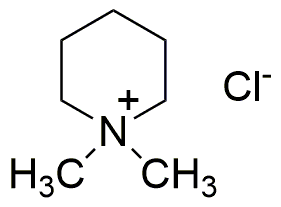1,1-Dimethylpiperidinium chloride is widely utilized in research focused on:
- Electrolytes in Energy Storage: This compound serves as a highly effective electrolyte in supercapacitors and batteries, enhancing energy density and charge/discharge rates, which is crucial for the development of efficient energy storage systems.
- Catalysis: It acts as a catalyst in various organic reactions, particularly in the synthesis of pharmaceuticals, enabling faster reaction times and improved yields compared to traditional catalysts.
- Corrosion Inhibition: In the coatings industry, it is used to formulate corrosion inhibitors, protecting metal surfaces in harsh environments, thus extending the lifespan of machinery and infrastructure.
- Biological Research: The compound is utilized in studies related to neurochemistry, where it can influence neurotransmitter systems, providing insights into neurological disorders and potential therapeutic pathways.
- Polymer Production: It is employed in the synthesis of polymers, particularly in the production of ionic liquids, which have applications in green chemistry and sustainable materials development.
General Information
Properties
Safety and Regulations
Applications
1,1-Dimethylpiperidinium chloride is widely utilized in research focused on:
- Electrolytes in Energy Storage: This compound serves as a highly effective electrolyte in supercapacitors and batteries, enhancing energy density and charge/discharge rates, which is crucial for the development of efficient energy storage systems.
- Catalysis: It acts as a catalyst in various organic reactions, particularly in the synthesis of pharmaceuticals, enabling faster reaction times and improved yields compared to traditional catalysts.
- Corrosion Inhibition: In the coatings industry, it is used to formulate corrosion inhibitors, protecting metal surfaces in harsh environments, thus extending the lifespan of machinery and infrastructure.
- Biological Research: The compound is utilized in studies related to neurochemistry, where it can influence neurotransmitter systems, providing insights into neurological disorders and potential therapeutic pathways.
- Polymer Production: It is employed in the synthesis of polymers, particularly in the production of ionic liquids, which have applications in green chemistry and sustainable materials development.
Documents
Safety Data Sheets (SDS)
The SDS provides comprehensive safety information on handling, storage, and disposal of the product.
Product Specification (PS)
The PS provides a comprehensive breakdown of the product’s properties, including chemical composition, physical state, purity, and storage requirements. It also details acceptable quality ranges and the product's intended applications.
Certificates of Analysis (COA)
Search for Certificates of Analysis (COA) by entering the products Lot Number. Lot and Batch Numbers can be found on a product’s label following the words ‘Lot’ or ‘Batch’.
*Catalog Number
*Lot Number
Certificates Of Origin (COO)
This COO confirms the country where the product was manufactured, and also details the materials and components used in it and whether it is derived from natural, synthetic, or other specific sources. This certificate may be required for customs, trade, and regulatory compliance.
*Catalog Number
*Lot Number
Safety Data Sheets (SDS)
The SDS provides comprehensive safety information on handling, storage, and disposal of the product.
DownloadProduct Specification (PS)
The PS provides a comprehensive breakdown of the product’s properties, including chemical composition, physical state, purity, and storage requirements. It also details acceptable quality ranges and the product's intended applications.
DownloadCertificates of Analysis (COA)
Search for Certificates of Analysis (COA) by entering the products Lot Number. Lot and Batch Numbers can be found on a product’s label following the words ‘Lot’ or ‘Batch’.
*Catalog Number
*Lot Number
Certificates Of Origin (COO)
This COO confirms the country where the product was manufactured, and also details the materials and components used in it and whether it is derived from natural, synthetic, or other specific sources. This certificate may be required for customs, trade, and regulatory compliance.


